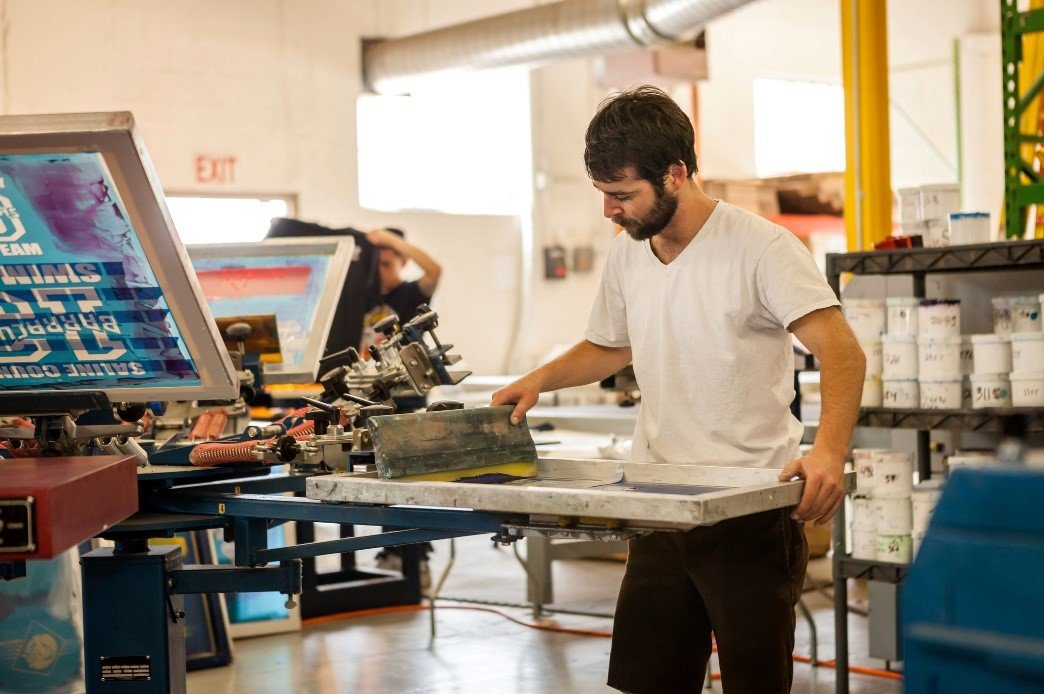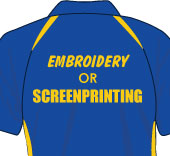Rumored Buzz on Tx Tees
Rumored Buzz on Tx Tees
Blog Article
The 8-Minute Rule for Tx Tees
Table of ContentsTx Tees Fundamentals ExplainedThe 3-Minute Rule for Tx TeesGetting The Tx Tees To WorkIndicators on Tx Tees You Should KnowSome Known Details About Tx Tees Tx Tees Can Be Fun For EveryoneTx Tees Fundamentals Explained
That brings your overall to about $1,900 prior to tax obligation and delivery. Accumulate other expenses, like the variety of energies it requires to run the shop and the expense of ink and solution per layout. embroidery shop. Take the print below for instance. This is a one-color photo, so the expense of ink per t-shirt is roughly 20 cents.The emulsion ought to just be a couple of cents given that you 'd only need to coat one screen for this job. Usually, printers attempt to make up to 45% earnings on a print work.

With DTF, you can print a handful of tee shirts, or simply one. Use the same calculator as the area over to calculate just how much revenue you 'd make utilizing DTF transfers. Compare the costs and earnings to whichever technique speaks ideal to your arrangement and process. Both display printing and DTF have their specific niches in the globe.
Tx Tees for Beginners
The very best means to know? Ask around and see what print stores like yours are doing. t-shirt printing. Try both out and see which you like much better
When you're picking what sort of printing technique to make use of for printing your artwork designs on your garments, it is necessary that you understand the differences between these two methods so you can make best use of results while lessening expenses. Display printing is one of the most generally used technique for printing designs on fabrics.
DTG printing is also called spot or direct to garment printing because it publishes only what is required as opposed to making a screen as display printers do. https://tuongs-ziancy-praurst.yolasite.com/. Screen printing functions by screen filler squeegee screen printing ink display mesh screen, then transferring the image to garment making use of warm and/or pressure
The DTG printer uses special dye-sublimation inks that are applied into a pre-designed picture by an electronic printing system. The inks become component of the fabric, permitting for vibrant shades and outstanding information. It's also called place or straight to garment printing because it prints only what is needed rather than making a display as screen printers do.
Indicators on Tx Tees You Need To Know
It's much faster - you can print a fullcolor picture in mins, as opposed to hours for screen printing. Second, there's no established up time or prices entailed - you can publish any kind of layout you such as, without having to produce a screen. Third, there's no waste - since screen printers screen print one design at a time, they need to screen each shade separately.
The paper is very costly and can just be utilized when. Once it's published on, it has actually to be discarded. - The first acquisition rate is less than the in advance investment of DTG printers- You can print multi-color designs one display at a time as opposed to having to publish each shade individually like DTG printing.

More About Tx Tees
However, rather of making use of screen mesh as screen printers do, color sublimation printers use laser innovation to move your images onto garments or paper. A warm procedure moves the color from its solid-state directly into the gas phase which consequently integrates it onto textile substrates when they are swiftly heated to high temperatures under high stress.
Sublimation printing is eco-friendly. It uses much less water than screenprinting, and due to the fact that it does not entail the usage of unsafe solvents, it's safe for all sorts of apparel. The color sublimation inks are likewise odor-free when healed, unlike display printers that make use of unsafe chemicals during the screen printing process that leave behind an unpleasant odor.
They additionally save go to the website money on costly equipment like exposure units because dye sublimation printers do not need a UV exposure unit or a flash cure oven that is normally made use of in display printing (custom monograming). What is straight to garment printing (DTG Printing)? DTG printing is an electronic screenprinting procedure that publishes directly onto fabric using specialized inkjet printers
The Best Guide To Tx Tees
DTG printing provides many advantages over standard screenprinting, including the capacity to print photo top quality pictures, greater shade vibrancy, and the capability to publish layouts on darker materials. DTG printers work by heating up the textile ink up until it turns into a gas. The gas after that permeates the textile, bonding with the fibers to develop a long-term print.

Display printers merely prepare their screen after that begin publishing up until they run out of product or ink.- There is a large range of skilled screen printers throughout the globe, which can be useful for beginners. - It's a slower procedure - display printers commonly have to wait on the ink to dry prior to they can publish the following shade- Screen printers need manual work, so there's a higher understanding contour and it takes longer to create a top notch style- Screen printing isn't as accurate as DTG printing, so you might get some "bleeding" of shades from one component of the picture onto another otherwise done correctly.
Tx Tees Things To Know Before You Get This
Rather of using screen mesh as display printers do, dye sublimation printers make use of laser technology to move your images onto garments or paper. A warm process moves the dye from its solid-state directly right into the gas stage which in turn integrates it onto fabric substratums when they are swiftly heated to heats under high stress.
Sublimation printing is green. It uses much less water than screenprinting, and due to the fact that it doesn't include making use of unsafe solvents, it's safe for all sorts of garments. The color sublimation inks are also unsmelling when treated, unlike screen printers that use dangerous chemicals throughout the display printing process that leave behind an undesirable smell.
They additionally save money on pricey tools like exposure units because color sublimation printers do not require a UV exposure unit or a flash cure oven that is usually made use of in display printing. What is straight to garment printing (DTG Printing)? DTG printing is an electronic screenprinting procedure that publishes straight onto material using specialized inkjet printers.
Not known Details About Tx Tees
DTG printing offers numerous benefits over conventional screenprinting, including the ability to publish photo quality images, greater shade vibrancy, and the capability to print styles on darker materials. DTG printers work by warming the fabric ink up until it develops into a gas. The gas after that penetrates the textile, bonding with the fibers to develop a long-term print.
Report this page